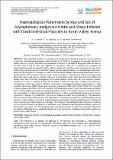| dc.description.abstract | Gastro-intestinal parasites are prevalent and directly impede livestock production causing impaired
productivity. Haematological parameters, which are likely to be influenced by parasites, are generally indicators of
healthy status in an animal. The effect of gastrointestinal infections on the health of indigenous cattle and sheep in
semi-arid areas is still not clear. The objective of the present study was to determine the prevalence of
gastrointestinal parasites in apparently healthy cattle and sheep kept under free-range management in upper Kerio
Valley Kenya and determine any associations between intestinal parasite infections and haematological parameters.
Blood and stool samples of 214 indigenous cattle and 82 sheep were evaluated. Haematological parameters from the
parasite-infected and non-parasite livestock were compared. Analyses of lymphocytes, polymorphonuclear white
blood cells, packed cell volume, red blood cell count and distribution width, white blood cell count (WBC) and
platelet count were performed. Strongyloides and Fasciola hepatica species were the most frequently isolated.
Overall, 37 (17.3%), 31 (14.5%) of cattle and 32 (39%), 8 (9.3%) of sheep faecal samples were positive for
Strongyloides and Fasciola hepatica infections respectively. Haematological variations significantly (p < 0.05)
existed for blood values (WBC, lymphocytes, monocytes, granulocytes, RBC, MCH, MCHC, RDW, PLT, and MPV)
in sheep between those infected and those uninfected with intestinal parasites. In cattle, the white blood cell (WBC)
(mean 15.10) and MPV (mean 8.9) were significantly higher compared with standard reference values (4-12 and 3.5-
6.5, respectively). The blood parameters significantly lower (p < .05) in nematode infected sheep were monocytes,
granulocytes, HGB and HCT while WBC, Lymphocytes, platelets and MPV were significantly (p < .05) elevated in
infected compared with uninfected sheep. The finding of Trichostrongyloides species and trematode parasites among
livestock in Kerio Valley is essential in understanding the epidemiology of gastrointestinal parasitic infection for
better comprehensive treatment and control strategies. The changes in haematological values as observed in infected
and non-infected livestock, can applied as an alternative means of diagnosis and understanding disease prognosis of
animal disease and status. The haematological values reported in this study, can also serve as baseline information
for selection of livestock that are genetically resistant to certain diseases and prevailing environmental conditions as
found in Kerio Valley, Kenya. | en_US |

